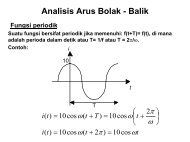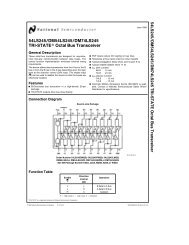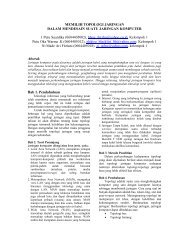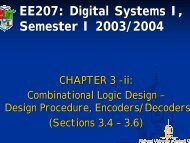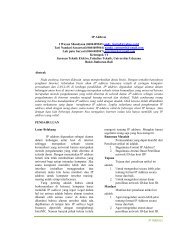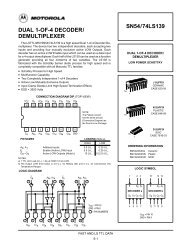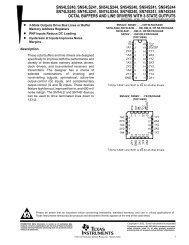SUN RADIATION
SUN RADIATION
SUN RADIATION
Create successful ePaper yourself
Turn your PDF publications into a flip-book with our unique Google optimized e-Paper software.
<strong>SUN</strong> <strong>RADIATION</strong><br />
MAGISTER TEKNIK ELEKTRO
PROPERTIES OF LIGHT<br />
Sunlight is a form of<br />
"electromagnetic radiation" and the<br />
visible light that we see is a small subset<br />
of the electromagnetic spectrum shown<br />
at the right.<br />
Light as a wave stated in the early 1800s<br />
Planck:<br />
total energy of light is made up of<br />
indistinguishable energy elements, or a<br />
quanta of energy.<br />
Einstein, distinguished the values of these<br />
quantum energy elements.<br />
MAGISTER TEKNIK ELEKTRO
Light may be viewed as consisting of "packets" or particles of energy,<br />
called photons.<br />
wave-particle wave particle duality<br />
Key characteristics of the incident solar energy :<br />
the spectral content of the incident light<br />
the radiant power density from the sun;<br />
the angle at which the incident solar radiation strikes a<br />
photovoltaic module;<br />
the radiant energy from the sun throughout a year or day for<br />
a particular surface.<br />
MAGISTER TEKNIK ELEKTRO
<strong>SUN</strong><br />
The sun is a hot sphere of gas whose internal temperatures<br />
reach over 20 million degrees kelvin due to nuclear fusion<br />
reactions at the sun's core which convert hydrogen to helium.<br />
The total power emitted by the sun is calculated by multiplying<br />
the emitted power density by the surface area of the sun which<br />
gives 9.5 x 1025 W<br />
Only a fraction of the total power emitted by the sun impinges on<br />
an object in space which is some distance from the sun. The<br />
solar irradiance (H0 in W/m2) is the power density incident on an<br />
object due to illumination from the sun.<br />
MAGISTER TEKNIK ELEKTRO
The solar radiation intensity, H 0 in (W/m 2 ), incident on an object is:<br />
H<br />
0 =<br />
R<br />
2<br />
sun<br />
H<br />
2 sun<br />
D<br />
where:<br />
H sun is the power density at the sun's surface (in W/m 2 ) as determined by<br />
Stefan-Boltzmann's blackbody equation;<br />
R sun is the radius of the sun in meters as shown in the figure below; and<br />
D is the distance from the sun in meters as shown in the figure below.<br />
MAGISTER TEKNIK ELEKTRO
The table below gives standardised values for the radiation at<br />
each of the planets.<br />
Planet<br />
Mercury<br />
Venus<br />
Earth<br />
Mars<br />
Jupiter<br />
Saturn<br />
Uranus<br />
Neptune<br />
Pluto<br />
Distance<br />
(x 10 9 m)<br />
57<br />
108<br />
150<br />
227<br />
778<br />
1426<br />
2868<br />
4497<br />
5806<br />
MAGISTER TEKNIK ELEKTRO<br />
Solar Constant<br />
(W/m 2 )<br />
9228<br />
2586<br />
1353<br />
586<br />
50<br />
15<br />
4<br />
2<br />
1
SOLAR <strong>RADIATION</strong> OUTSIDE THE EARTH<br />
MAGISTER TEKNIK ELEKTRO<br />
The solar radiation outside the<br />
earth's atmosphere is calculated<br />
using the radiant power density<br />
(H sun ) at the sun's surface (5.961 x<br />
107 W/m2), the radius of the sun<br />
(R sun ), and the distance between the<br />
earth and the sun. The calculated<br />
solar irradiance at the Earth's<br />
atmosphere is about 1.36 kW/m2.<br />
The actual power density varies slightly since the Earth-Sun<br />
distance changes as the Earth moves in its elliptical orbit around<br />
the sun, and because the sun's emitted power is not constant.<br />
The power variation due to the elliptical orbit is about 3.4%,
An equation describe the variation through out the year just outside the<br />
earth atmosphere:<br />
H<br />
H<br />
const<br />
=<br />
1<br />
+<br />
0.<br />
033<br />
cos(<br />
360<br />
( n<br />
365<br />
where:<br />
H is the radiant power density outside the Earth's atmosphere (in W/m2);<br />
H const is the value of the solar constant, 1.353 kW/m2; and<br />
n is the day of the year.<br />
−<br />
2)<br />
MAGISTER TEKNIK ELEKTRO<br />
)
SOLAR <strong>RADIATION</strong> ON THE EARTH’S EARTH S SURFACE<br />
The radiation at the Earth's surface varies widely due to:<br />
oatmospheric effects, including absorption and scattering;<br />
olocal variations in the atmosphere, such as water vapour, clouds,<br />
and pollution;<br />
olatitude of the location; and<br />
othe season of the year and the time of day.<br />
The amount of energy reaching the surface of the Earth every hour is<br />
greater than the amount of energy used by the Earth's population<br />
over an entire year.<br />
MAGISTER TEKNIK ELEKTRO
ATMOSPHERIC EFFECTS<br />
The major effects for photovoltaic applications<br />
are:<br />
a reduction in the power of solar radiation due<br />
to absorption, scattering, reflection in the<br />
atmosphere<br />
a change in the spectral content of the solar<br />
radiation due to greater absorption or scattering<br />
of some wavelengths<br />
local variation in the atmosphere (water vapour,<br />
clouds and pollution) which have additional effect<br />
on the incident power, spectrum and directional<br />
MAGISTER TEKNIK ELEKTRO
EFFECT OF AIR MASS<br />
The Air Mass quantifies the reduction in the power of light as it<br />
passes through the atmosphere and is absorbed by air and dust.<br />
The Air Mass is defined as:<br />
AM<br />
=<br />
1<br />
cos( θ )<br />
where θ is the angle from<br />
the vertical (zenith angle).<br />
When the sun is directly<br />
overhead, the Air Mass is 1.<br />
MAGISTER TEKNIK ELEKTRO
An easy method to determine the air<br />
mass is from the shadow of a vertical pole<br />
AM<br />
=<br />
⎛ s ⎞<br />
1 + ⎜ ⎟<br />
⎝ h ⎠<br />
assuming the atmosphere is flat layer<br />
2<br />
MAGISTER TEKNIK ELEKTRO
SOLAR TIME<br />
LOCAL SOLAR TIME (LST) & LOCAL TIME (LT)<br />
Twelve noon local solar time (LST) is defined as when the sun is highest<br />
in the sky.<br />
Local time (LT) usually varies from LST because of the eccentricity of the<br />
Earth's orbit, and because of human adjustments such as time zones and<br />
daylight saving.<br />
LOCAL STANDART TIME MERIDIAN (LSTM)<br />
The Local Standard Time Meridian<br />
(LSTM) is a reference meridian used<br />
for a particular time zone and is<br />
similar to the Prime Meridian, which is<br />
used for Greenwich Mean Time.<br />
MAGISTER TEKNIK ELEKTRO<br />
The LSTM is calculated by:<br />
LSTM = . Δ<br />
15 0<br />
TGMT<br />
where ∆T GMT is the difference of the Local Time (LT) from Greenwich<br />
Mean Time (GMT) in hours. 15°= 360°/24 hours
EQUATION OF TIME<br />
The equation of time (EoT) (in minutes) is an empirical equation that<br />
corrects for the eccentricity of the Earth's orbit and the Earth's axial<br />
tilt.<br />
EoT = 9. 87sin(<br />
2B)<br />
− 7.<br />
53COS(<br />
B)<br />
−1.<br />
5sin(<br />
B)<br />
where<br />
360<br />
B = ( d − 81)<br />
365<br />
The time correction EoT is plotted<br />
in degrees and d is the number of<br />
days since the start of the year<br />
MAGISTER TEKNIK ELEKTRO
TIME CORRECTION FACTOR<br />
TC = 4(<br />
LSTM − Longitude)<br />
+<br />
EoT<br />
The net Time Correction Factor (in minutes) accounts for the variation of<br />
the Local Solar Time (LST) within a given time zone due to the longitude<br />
variations within the time zone and also incorporates the EoT<br />
The factor of 4 minutes comes from the fact that the Earth rotates<br />
1° every 4 minutes<br />
LOCAL SOLAR TIME LST= LT + TC<br />
HOUR ANGLE (HRA)<br />
HRA= 15 0 (LST – 12)<br />
The Hour Angle converts the local solar time (LST) into the<br />
number of degrees which the sun moves across the sky. By<br />
definition, the Hour Angle is 0° at solar noon. Since the Earth<br />
rotates 15° per hour, each hour away from solar noon corresponds<br />
to an angular motion of the sun in the sky of 15°. In the morning<br />
the hour angle is negative, in the afternoon the hour angle is<br />
positive.<br />
MAGISTER TEKNIK ELEKTRO
Latitude of interest ϕ<br />
Equator<br />
Axis parallel to<br />
the sunlight<br />
ELEVATION ANGLE<br />
Earth<br />
δ<br />
ϕ<br />
δ<br />
North<br />
zenith angle<br />
The elevation angle can be calculate as:<br />
α<br />
MAGISTER TEKNIK ELEKTRO<br />
The zenith angle is the angle<br />
between the sun and the vertical.<br />
zenith = 90° -elevation.<br />
ζ=ϕ-δ<br />
Elevation angle<br />
sin 1 −<br />
[ sin δ sin φ + cos cos( HRA)<br />
]<br />
Elevation =<br />
δ
ELEVATION ANGLE<br />
To calculate the sunrise and sunset time the equation for elevation is<br />
set to zero and the elevation equation<br />
1 −1⎡<br />
sinφ<br />
sin γ ⎤ TC<br />
Sunrise = 12 − cos<br />
−<br />
0 ⎢ ⎥<br />
15 ⎣cosφ<br />
cosδ<br />
⎦ 60<br />
1 −1⎡<br />
sinφ<br />
sinδ<br />
⎤ TC<br />
Sunrise = 12 + cos<br />
−<br />
0 ⎢ ⎥<br />
15 ⎣cosφ<br />
cosδ<br />
⎦ 60<br />
MAGISTER TEKNIK ELEKTRO
AZIMUTH ANGLE<br />
The azimuth angle is the compass direction from which the sunlight is<br />
coming<br />
Azimuth<br />
=<br />
−<br />
cos 1<br />
⎡sinδ cosφ<br />
− cosγ<br />
sinφ<br />
cos( HRA)<br />
⎢<br />
⎣<br />
cosα<br />
MAGISTER TEKNIK ELEKTRO<br />
⎤<br />
⎥<br />
⎦
SOLAR <strong>RADIATION</strong> ON TILTED SURFACE<br />
The power incident on a PV module depends on:<br />
•the power contained in the sunlight<br />
•the angle between the module and the sun.<br />
The power density will always be at its maximum when the PV module is<br />
perpendicular to the sun<br />
However, as the angle between the sun and a fixed surface is continually<br />
changing, the power density on a fixed PV module is less than that of the<br />
incident sunlight.<br />
MAGISTER TEKNIK ELEKTRO<br />
continued
The figure shows how to calculate the radiation incident on a<br />
titled surface (S module ) given either the solar radiation measured<br />
on horizontal surface (S horiz ) or the solar radiation measured<br />
perpendicular to the sun (S incident ).<br />
The equations:<br />
S horizontal = S incident sinα<br />
S module = S incident sin (α + β)<br />
where<br />
α is the elevation angle (α = 90-ϕ+∂ ) latitude + declination angle<br />
β is the tilt angle of the module measured from<br />
the horizontal.<br />
Therefore:<br />
S<br />
module<br />
S<br />
= horizontal<br />
sinα<br />
MAGISTER TEKNIK ELEKTRO<br />
sin( α + β )<br />
0 ⎡360<br />
⎤<br />
δ = 23.<br />
45 sin⎢<br />
( 284 + d)<br />
⎥<br />
⎣365<br />
⎦
USING VECTOR TO CALCULATE SOLAR DIRECTION<br />
As the number of tilts and orientations become more complicated it is<br />
often easier to convert the solar directions of azimuth and elevation to<br />
vectors.<br />
S module = S incident cosγ = S incident S.N<br />
MAGISTER TEKNIK ELEKTRO



